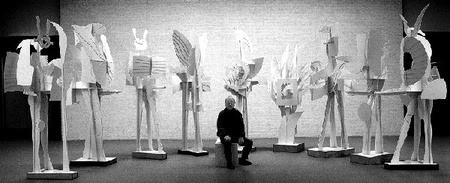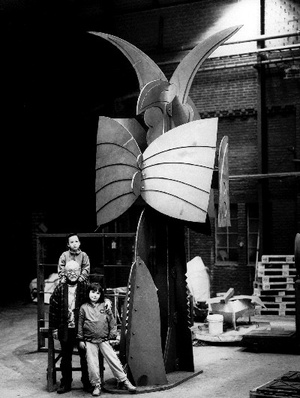On December 7, 2003, on his 80th birthday, artist Shinkichi Tajiri was honored by the Dutch art world, friends and family, with the opening of a retrospective exhibition at the Valkhof Museum in Nijmegen, the Netherlands. The show encompassed more than half a century of diverse works.
At the entrance, visitors were welcomed by the latest addition to the prolific artist’s oeuvre, a lineup of 47 Ronin (based on the 18th-century tale of masterless samurai who defend the honor of their deceased master). The nearly nine-foot-tall warriors, sculpted out of foam board —part monstrous fighting machines, part hard core sensuality— embody Shinkichi’s trademark duality. The American-born artist never has liked being put in a box. And with his art he strives to stay far away of any kind of preconceived notion, inviting his audience to do the same.
Shinkichi turned 18 on December 7, 1941, when the Japanese army attacked the U.S. airfield in Hawaii. Shinkichi, his mother and siblings (his father died in 1939) were sent to Poston, AZ internment camp. Out of a muddle of patriotic sensibility and an urge to leave the camp, Shinkichi volunteered for the Army. His future unit, the all-Japanese American 100th/442nd Regimental Combat Team, became the most decorated of its size in American military history. On July 9, 1944 Shinkichi was injured during an attack on Castellina, Italy (stone fragments are still lodged in his bones). During his physical rehabilitation in Europe he began drawing fellow soldiers and war scenes.
Shinkichi’s central themes—speed, erotica, force or violence—are a permanent confrontation with the insanity of WWII and its aftermath. “You need obsession to continue, to not give up,” he says. “Thanks to the war, I became an artist. I’m an artist out of necessity. My imagery is the crystallization of my experiences.”
fter reuniting with his family in Chicago, Shinkichi worked at the studio of Isamu Noguchi in New York. The G. Bill enabled him to study for one year at the Art Institute of Chicago before leaving for Paris, France in 1948 to continue his studies with Ossip Zadkine and Fernand Léger.
In those days everybody who was, or would be, somebody, lived in Paris. Many Americans were in self-imposed exile from racism —war veteran Shinkichi was welcomed home as a "Jap"— and the foul political climate in the US. In Europe, Shinkichi met and was influenced by members of the CoBrA Art Movement, named for the artists’ origins in Copenhagen, Brussels and Amsterdam. Because of shortages after the war, artists used all kinds of material in their work, Shinkichi created his earliest sculptures out of found scrap metal.
In 1956 Shinkichi left for Amsterdam with Dutch artist Ferdi Jansen, whom he married and in 1957. In 1962 they moved with daughters Giotta Fuyo and Ryu Vinci to Baarlo, a village in the most southern province of the Netherlands. The industrious couple renovated a dilapidated castle, creating living quarters and extensive art studios. With the arrival of a Japanese American expatriate, Baarlo —far away from Amsterdam— was put on the artistic map of the Netherlands.
Among Shinkichi’s series are his “Knots.” Forged out of steel, or created of wood, polyester or fiber glass, they mark meditative meeting points. His Granny’s Knot is installed at the Nelson Rockefeller Foundation in New York, and at the Museum of Modern Art at Aarhus, Denmark. In Los Angeles, his “Friendship Knot” in Little Tokyo can’t be missed. [Editor’s note: another Knot marks a memorial to soldiers who saved the “Lost Battalion;” see story "Remembered Valor"]. When asked about the source of inspiration for his Knots series, Shinkichi answered that the exhaust pipe of his 6-cylinder BRM led to the earliest curved tubular creations. “Everybody has certain connotations and associations about knots,” he says. “I was looking for instant communication.”
On January 2, 1969, Ferdi died. One of the first of the Knots series, the 4x2 Knot, stands on her grave, a beautiful memorial and symbol of eternal alliance. In 1976, Shinkichi married his present wife, Suzanne van de Capellen. One of the first to use computer imaging, the octogenarian artist stays abreast of the latest technology, and in addition to art in public places, he has created award-winning films, videos, stereo and panoramic photos, daguerreotypes works on paper, specialty books and a huge body of sculpture. He continues adding to his wondrous world, never ceasing to astonish his audience.
* This article was originally published in Nikkei Heritage Vol. XVII, no.1 (Spring 2005), a journal of the National Japanese American Historical Society.
© 2005 National Japanese American Historical Society






